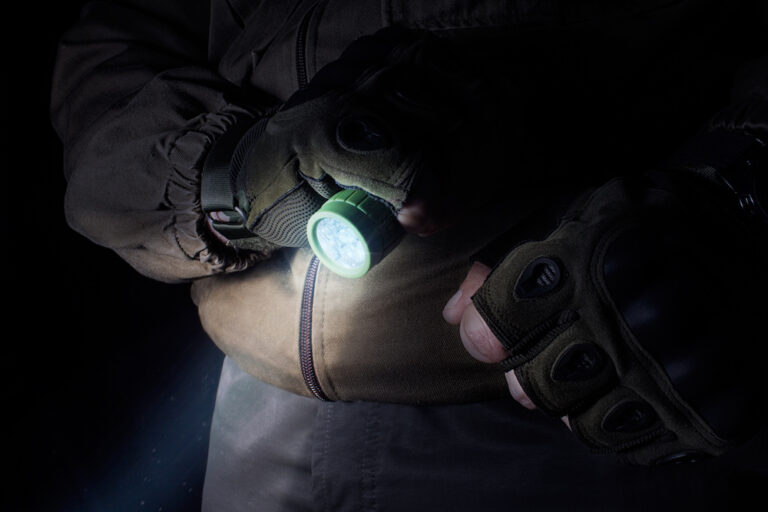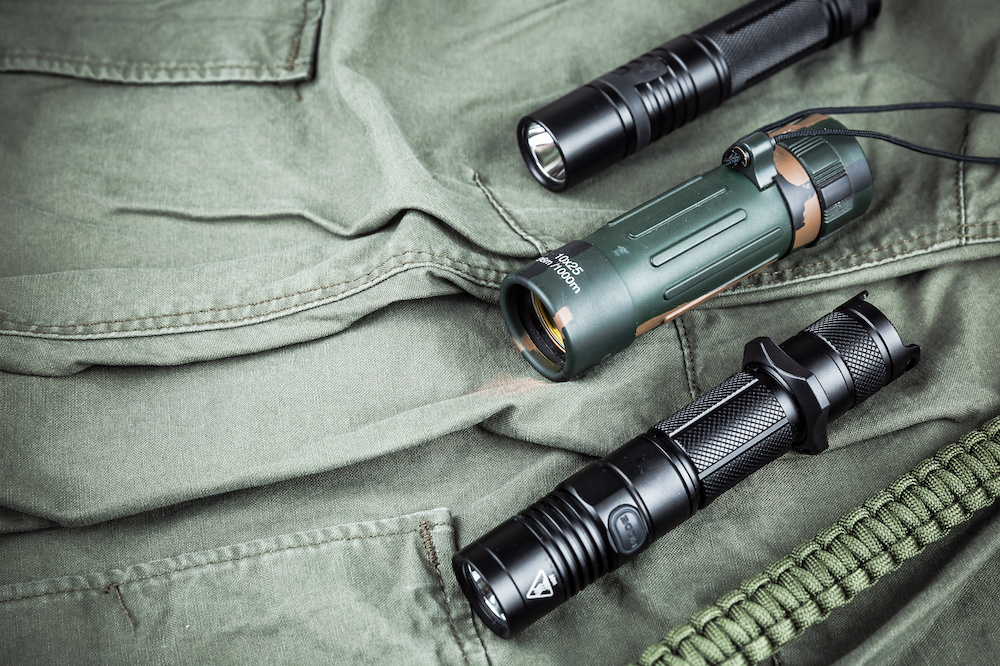Signup for our monthly newsletter and get your FREE "Tactical Gear" Guide
How To Hold a Tactical Flashlight: Common Practices and Proper Technique
- Home
- Tactical Flashlight Advice
- How To Hold A Tactical Flashlight

This site contains affiliate links to products. We may receive a commission for purchases made through these links.
When mobile phones started to have built-in flashlights, battery powered flashlights have dwindled in households.
You might ask: why would you need a normal flashlight when cell phone flashlights can already get the job done?
With the advances in flashlight technology, modern flashlights now have tactical purposes that make them more of an everyday carry item.
However, it would be best to know how to hold a tactical flashlight to take advantage of these features.
Table of Contents
What Are Tactical Flashlights?
Why Flashlights Are Essential for Self-Defense
- Threat Identification and Dispersion
- Obstacle Avoidance
- Armed Attacker Disorienting
- Weapon Improvisation
- Emergency Response
How To Choose the Best Flashlight for Tactical Purposes
The Disadvantages of Weapon-Mounted Lights
What Are Tactical Flashlights?
In simple terms, tactical flashlights are everyday carry or handheld lights designed for tactical applications, including self-defense, search and rescue, and target acquisition.
Unlike ordinary household flashlights, tactical flashlights are much smaller, have more durable construction, and produce bright lights.
In fact, tactical flashlights are the best household flashlights you can get.
The brighter light beam produced efficiently illuminates low-light environments, and the size keeps the flashlight handy at all times.
Although a bright LED flashlight can pass off as a tactical tool, a good-quality tactical flashlight carries several lighting modes for various purposes.
With recent compact flashlight innovations, you will find that tactical flashlights offer several brightness levels, a strobe function, and maybe even an SOS function.
Modern flashlights for tactical applications typically have an all-metal body with a serrated bezel.
In addition to improved durability, this feature amplifies a tactical flashlight’s capability of being a self-defense tool.
Why Flashlights Are Essential for Self-Defense
A flashlight can be convenient in the toughest of situations, even without a gun for self-defense.
Unlike guns, you can bring flashlights into spaces where firearms are otherwise restricted.
You can take a flashlight into airports, aircraft, movie theaters, pubs, and dance clubs.
Furthermore, you can have one on your person in countries that ban carrying and concealing a gun.
More importantly, unlike a gun, a flashlight is safe enough to leave lying around, even for children to see.
Aside from these reasons, the following list outlines the personal defense capabilities of a bright LED flashlight.
Threat Identification and Dispersion
First off, with a flashlight handy at all times, you can easily identify incoming threats.
A flashlight is essential for low-light shooting because target acquisition is simpler with illumination.
Your gun sights are always visible, and you can quickly identify your targets.
In any attacker situation, an aggressor will take advantage of the cover of poorly lit spaces.
With a flashlight, you can pinpoint threats in low-light environments and gain the upper hand against any stalker hiding in the shadows.
Simply flashing a light towards predators can be enough to drive them away.
Obstacle Avoidance
Like any possible threats, obstacles can be invisible in pitch-black environments.
Large and heavy objects can prevent you from escaping dire situations, and scattered items will require you to tread lightly and carefully.
With a flashlight handy at all times, you can avoid accidental injuries.
Armed Attacker Disorienting
For those of you who don’t know, the strobe function of a tactical flashlight generates bright flashing lights that can be very disorienting.
However, even without a strobe mode, the constant bright LED light that a tactical flashlight produces efficiently functions as a temporarily blinding self-defense light.
Human eyes have a naturally sensitive reaction to extremely bright lights, and in many cases, can even receive irreversible damage.
Disorienting with a bright beam of light is exceptionally helpful against attackers using night vision equipment.
Stealthy aggressors use night vision equipment for aiming at night and in the dark to avoid using flashlights and prevent giving away their position.
Bright white and blue lights are not typically used with night vision equipment.
By flashing a bright light into the field of view of someone wearing such equipment, their view scope goes wholly white or completely black.
Whenever an armed attacker poses a grave threat, you can flash your light into their eyes and give them a few seconds of temporary blindness.
During this brief moment, you can either flee or counterattack.
Weapon Improvisation
Once you’ve learned the ropes of target acquisition and disorienting with a tactical flashlight, you can move on to improvising it as a weapon.
A good-quality tactical flashlight is impact-proof with its all-metal body, and it will have a toothed or serrated bezel.
Some manufacturers call this bezel a strike face, an exceptional surface for striking an attacker.
The trick with the strike face is to know how to hold a tactical flashlight when using it as an improvised weapon.
Emergency Response
Since a tactical flashlight is extremely durable, you can use it as a tool during any emergency scenario.
Its serrated edge, in particular, is perfect for breaking through windows to escape any situation.
Alternatively, you can use the concentrated beam to send emergency signals from afar.
If you know Morse Code, you can use the bright LED light to generate short and long flashes to send out messages.
Some tactical flashlights feature an SOS mode, which automatically sends out Morse Code light flashes equivalent to the SOS letters.

How To Choose the Best Flashlight for Tactical Purposes
When choosing a tactical flashlight, there are some factors you might want to consider before making a purchase.
The following list outlines these factors:
Portability and Handling
A tactical flashlight can only be handy if it is small. It is best to get something that you can put in your pocket as an everyday carry tool.
It should not be anything bigger than the size of your palm if you want to use it inconspicuously.
Having the right size tactical flashlight is more advantageous for handling than an awkwardly large device.
Some extra features to look for include an ergonomic grip, a grip for recoil issues, a hand strap, or a removable pocket clip.
Light Output
For a flashlight to be even considered tactical, it must generate light bright enough to make things visible and disorient onlookers.
If you’re looking for something affordable, stick with those that produce at least 120 lumens.
Anything below 120 lumens can’t provide enough illumination and much less disorient an attacker.
Many tactical variants of rechargeable flashlights can now produce thousands of lumens from one device.
However, having over 1000 lumens is more than enough to stick with a handy option.
Lighting Modes
Having all the lumens you need at your fingertips would be enough, but you can gain a better tactical advantage with various light modes.
Many tactical flashlights offer bright, medium bright, and low light modes with the flick of a switch or the press of a button.
You might also want to choose a device with the strobe and SOS functions for self-defense situations and emergencies.
Finally, some flashlights have a zoom function that enables you to switch between a wide-angle or concentrated light beam.
Durability
A good tactical flashlight should survive forceful impacts and withstand rain and other harsh weather conditions.
While you might find waterproof variants, those that combine protection against particulate matter and moisture are best.
Power Source
Of course, you will need a reliable power source to produce high light outputs from a tactical flashlight.
Simpler models use AA and AAA batteries, while more advanced variants take advantage of more powerful CR123 A and 18650 batteries.
On the other hand, some products have built-in batteries, which are not very convenient due to the charging downtime.
You will find that the most common small tactical flashlights of today use a single (1) 18650 lithium-ion rechargeable battery.
Nevertheless, you will also find variants that are compatible with different types of batteries.
Purpose
Tactical flashlights come in several forms: typical cylindrical handheld lights, weapon-mountable lights, and dual-purpose convertible variants.
Dual-purpose variants offer the appearance of typical handheld flashlights, and they come with standard mounts for many types of firearms.
Unless you are looking for a tactical flashlight solely for law enforcement or military target acquisition, weapon-mounted lights are not the best option.
Even if you own a gun, it is still better to have a separate flashlight that stands apart from your weapon.
The following section explains why.
The Disadvantages of Weapon-Mounted Lights
Weapon-mounted lights are extremely convenient because all you have to do is grab one item to get going.
However, they also pose some problems.
For starters, weapon-mounted lights only cater to people who own or use a gun.
While they may stand alone as handheld lights, their built-in mounts make them somewhat bulky and not too conducive for handling.
Secondly, it takes the safety factor down a notch.
Using a weapon-mounted light requires you to point your gun where you want to direct the light.
You wouldn’t want to be pointing the gun at a false target such as your kid now, would you?
Finally, unless your weapon-mounted light comes with a momentary-on pressure switch, you’re a moving target for hidden attackers.
How To Hold a Tactical Flashlight
With a weapon-mounted light, you won’t have to hold the flashlight as long as you have learned the responsibilities of handling a weapon.
The best way to keep the element of surprise is to have a pressure switch with the mounted light.
This way, all you have to do is hold the switch using a free hand and press it every time you need the light.
When using a separate flashlight for target acquisition, several time-tested flashlight techniques for handling a weapon are used.
Flashlight Shooting Techniques
Since rifles require both hands and arms for operation, they are best accompanied by mounted lights for target acquisition.
Alternatively, the following methods are more suitable for a handgun and a separate flashlight.
The Chapman Technique
This technique was initially developed for flashlights having a side-mounted switch.
With your gun on your dominant hand and aiming position, clench the flashlight with the palm of your non-dominant hand, palm facing up.
The flashlight’s side-switch should be secured close to your thumb so that you can turn the light on or off as intended.
Position your hand holding the flashlight firmly beside your shooting hand to aim the light on your target and add stability for shooting.
This technique works well with all versions of veteran-style flashlights.
Isosceles or modified-isosceles shooters will find this method very easy to assume during target acquisition.
However, it can be difficult for those with small hands, heavy flashlights, and when used for an extended period.
The Ayoob Technique
Like the Chapman Technique, the Ayoob is a hands-together flashlight technique limited to use only with side-switching flashlights.
In the Ayoob technique, the thumb holding your gun’s grip is parallel to the thumb holding the flashlight.
This position entails that your non-dominant hand is gripping the flashlight like a sword, palm facing the gun grip.
Unlike the Chapman, the Ayoob requires less training to master, and the touching thumbs add traction that stabilizes the gun.
The Rogers Technique
Another hands-together technique is the Rogers, also called the SureFire Technique.
Compared to the Chapman and the Ayoob, the Rogers uses a two-handed grip that provides more stability for gun handling.
Grip the gun as you would using a two-handed firing grip and position the flashlight between the index and middle fingers of your non-firing hand.
Imagine how this technique feels, and notice that it is more suitable for small tactical flashlights with a tail cap push button switch.
The Harries Technique
The Harries Technique is the go-to method for many handgun tacticians.
While it is also a hands-together method, it gives you the option to point the flashlight away from the muzzle.
This practice is beneficial when you want to disorient an attacker from the exact source of an incoming muzzle flash.
Hold the flashlight with your non-firing hand’s thumb on the tail cap push button switch, palm facing downward.
In this position, pointing the flashlight away from you means your thumb is closer to your chest.
Grip your gun with your dominant hand, and rest your firing arm over the wrist of your flashlight underhand.
You can also use this method with flashlights having side-mounted switches, as long as you can conveniently turn it on or off with any finger.
The Harries is the least fatiguing for extended use among the four techniques.
The Most Professionally Acclaimed Proper Techniques
While there may not be one proper technique for holding a tactical flashlight with a gun, experts have devised two logical ways for improved safety.
The problem with the four techniques above is that you leave your head prone to attacks from behind.
With the following methods, you may reduce firing stability but add an extra layer of defense using hands-apart techniques.
The Neck-Index Method
When doing the Neck-Index Method, hold the flashlight like an ice pick and grip it against the jaw or neck juncture below your ear.
Doing so allows the light to move with your head to prevent blocking your peripheral views.
You can apply this method using extra-large flashlights with the body resting over your shoulder and indexed against your neck.
This method is exceptionally functional for users with an injured arm, but it can draw enemy fire to the user’s head.
The Modified FBI Method
In the Modified FBI Method, hold the flashlight like gripping a sword or an ice pick and extend the flashlight arm away from your body and firing hand.
Position the flashlight slightly in front of your body to avoid self-illumination.
This method prevents users from exposing their position using intermittent lighting at random heights.
As a result, this method can draw away enemy fire from the user’s center of mass.
In addition, the Modified FBI Method allows easy transitions to and from the Neck-Index Method.
Holding the Tactical Flashlight Properly
If you don’t have a firearm with you when using your tactical flashlight for self-defense, always hold it like gripping an ice pick.
Doing so ensures that you can use its serrated bezel to strike incoming attackers.
Remember that not all situations call for a highly defensive position such as this one.
You can always use the Flash and Scan method whenever you hear something in the dark and like to investigate.
All you have to do is stand still, turn the light on, create a mental map, turn the light off, move carefully, and then repeat.
